
The Pacific Electric Railway Company, nicknamed the Red Cars, was a privately owned mass transit system in Southern California consisting of electrically powered streetcars, interurban cars, and buses and was the largest electric railway system in the world in the 1920s. Organized around the city centers of Los Angeles and San Bernardino, it connected cities in Los Angeles County, Orange County, San Bernardino County and Riverside County.

The Los Angeles County Metropolitan Transportation Authority (LACMTA), branded as Metro, is the county agency that plans, operates, and coordinates funding for most of the public transportation system in Los Angeles County, California, the most populated county in the United States.
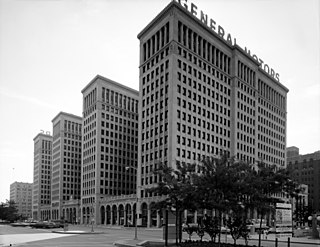
The General Motors streetcar conspiracy refers to the convictions of General Motors (GM) and related companies that were involved in the monopolizing of the sale of buses and supplies to National City Lines (NCL) and subsidiaries, as well as to the allegations that the defendants conspired to own or control transit systems, in violation of Section 1 of the Sherman Antitrust Act. This suit created lingering suspicions that the defendants had in fact plotted to dismantle streetcar systems in many cities in the United States as an attempt to monopolize surface transportation.

The G Line is a bus rapid transit line in Los Angeles, California, operated by the Los Angeles County Metropolitan Transportation Authority (Metro). It operates between Chatsworth and North Hollywood stations in the San Fernando Valley. The 17.7-mile (28.5 km) G Line uses a dedicated, exclusive right-of-way for the entirety of its route with 17 stations located at approximately one-mile (1.6 km) intervals; fares are paid via TAP cards at vending machines on station platforms before boarding to improve performance. It is one of the two lines in the Los Angeles Metro Busway system.
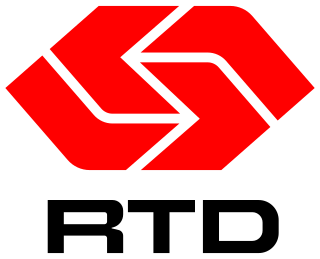
The Southern California Rapid Transit District was a public transportation agency established in 1964 to serve the Greater Los Angeles area. It was the successor to the original Los Angeles Metropolitan Transit Authority (MTA). California State Senator Thomas M. Rees sponsored the bill that created the RTD, which was meant to correct some deficiencies of the LAMTA, and took over all of the bus service operated by MTA on November 5, 1964. RTD was merged into the Los Angeles County Metropolitan Transportation Authority in 1993.
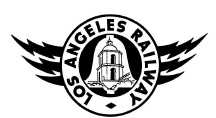
The Los Angeles Railway was a system of streetcars that operated in Central Los Angeles and surrounding neighborhoods between 1895 and 1963. The system provided frequent local services which complemented the Pacific Electric "Red Car" system's largely commuter-based interurban routes. The company carried many more passengers than the Red Cars, which served a larger and sparser area of Los Angeles.

The 175th Street station is a station on the IND Eighth Avenue Line of the New York City Subway. Located in the Washington Heights neighborhood in Upper Manhattan, at the intersection of 175th Street and Fort Washington Avenue, it is served by the A train at all times.
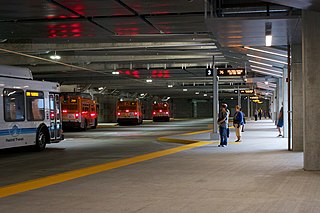
The Los Angeles County Metropolitan Transportation Authority operates a vast fleet of buses for its Metro Bus and Metro Busway services. As of September 2019, Metro has the third largest bus fleet in North America with 2,320 buses.

The Santa Barbara Metropolitan Transit District (MTD) is a public transit agency providing bus service in the southern portion of Santa Barbara County, California. It serves the cities of Santa Barbara, Carpinteria, and Goleta as well as the unincorporated areas of Montecito, Summerland, and Isla Vista. In 2023, the system had a ridership of 4,579,600, or about 16,400 per weekday as of the fourth quarter of 2023.
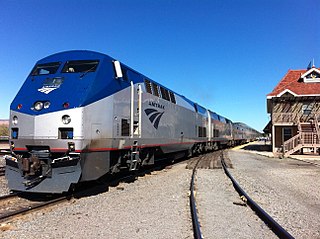
The United States is serviced by a wide array of public transportation, including various forms of bus, rail, ferry, and sometimes, airline services. Most established public transit systems are located in central, urban areas where there is enough density and public demand to require public transportation. In more auto-centric suburban localities, public transit is normally, but not always, less frequent and less common. Most public transit services in the United States are either national, regional/commuter, or local, depending on the type of service. Sometimes "public transportation" in the United States is an umbrella term used synonymously with "alternative transportation", meaning any form of mobility that excludes driving alone by automobile. This can sometimes include carpooling, vanpooling, on-demand mobility, infrastructure that is oriented toward bicycles, and paratransit service. There is public transit service in most US cities.
This article discusses the history of the Los Angeles County Metropolitan Transportation Authority, the regional transportation planning agency for Los Angeles County, California.
V was a streetcar service in Los Angeles, California. It was operated by the Los Angeles Railway from 1920 to 1958, and by the Los Angeles Metropolitan Transit Authority from 1958 to 1963.
5 or the 5 Car was a streetcar line operated by the Los Angeles Railway, later named the Los Angeles Transit Lines, and by the Los Angeles Metropolitan Transit Authority. From 1920 to 1932, this route was known as the E Car. This was changed as part of a method to distinguish routes that lacked loops at their termini. Consequently, the 5 Car was unique during the LAMTA era in that it did not use PCC streetcars. It used buses from 1955 to 1964, transferring from LATL in 1958, then splitting the line in two in 1961, until all lines were turned over to SCRTD in August 1964.

The Q58 and Q58 Limited are bus routes that constitute a public transit line operating primarily in Queens, New York City, with its southern terminal on the border with Brooklyn. The Q58 is operated by the MTA New York City Transit Authority. Its precursor was a streetcar line that began operation in November 1899. and was known variously as the Flushing–Ridgewood Line, the Corona Avenue Line, and the Fresh Pond Road Line. The route became a bus line in 1949.

The Bx15 and M125 bus routes constitute the Third Avenue/125th Street Line, a public transit line in New York City. The Bx15 runs between Fordham Plaza and the Hub in the Bronx, running primarily along Third Avenue. The M125 runs between the Hub in the Bronx and Manhattanville in Manhattan, running along Willis Avenue in the South Bronx and along 125th Street in Harlem, Manhattan.

The Q72 bus route constitutes a public transit route along Junction Boulevard and 94th Street in Queens, New York City. It operates between the Rego Park and East Elmhurst neighborhoods of Queens, and extends into LaGuardia Airport at the north end of the borough. It is city-operated under the MTA Bus Company brand of MTA Regional Bus Operations.

The New York City Board of Transportation or the Board of Transportation of the City of New York was a city transit commission and operator in New York City, consisting of three members appointed by the mayor. It was created in 1924 to control city-owned and operated public transportation service within the New York City Transit System. The agency oversaw the construction and operation of the municipal Independent Subway System (IND), which was constructed shortly after the Board was chartered. The BOT later presided over the major transfers of public transit from private control to municipal control that took place in the 1940s, including the unification of the New York City Subway in 1940. In 1953, the Board was dissolved and replaced by the state-operated New York City Transit Authority, now part of the Metropolitan Transportation Authority (MTA).
The history of the Los Angeles Metro Rail and Busway system begins in the early 1970s, when the traffic-choked region began planning a rapid transit system. The first dedicated busway opened along I-10 in 1973, and the region's first light rail line, the Blue Line opened in 1990. Today the system includes over 160 miles (260 km) of heavy rail, light rail, and bus rapid transit lines, with multiple new lines under construction as of 2019.
Pico/Rimpau is an area of Mid-City, Los Angeles, at the junction of Pico Boulevard, Rimpau Street, San Vicente Boulevard, Venice Boulevard, Vineyard Avenue and West Boulevard. This area is the location of several key former and current transportation hubs and retail shopping centers for the Los Angeles area.
















